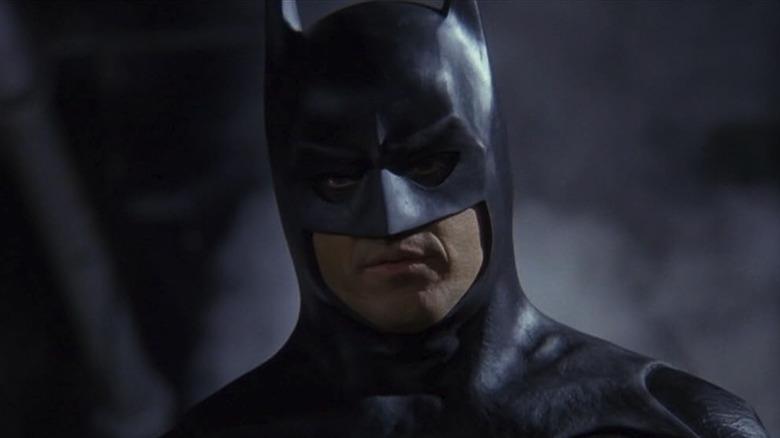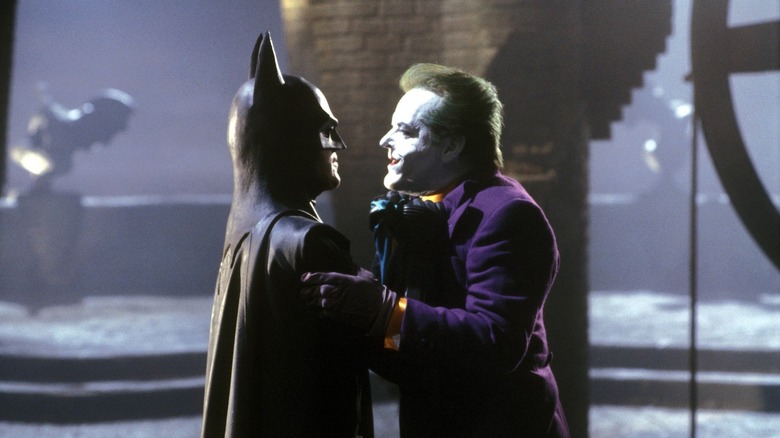Tim Burton's Batman Shares Its Climax With A Groundbreaking Sci-Fi Classic
This post contains spoilers for "Metropolis" and Tim Burton's "Batman."
The colossal Gotham Cathedral, which stands more than 800 feet tall and towers over every other skyscraper in Gotham, is turned into a battleground towards the end of Tim Burton's "Batman." The director's distinct, often eccentric visual aesthetic directly informs the film's moody, noir-tinted visuals, the atypical camera angles and editing choices adding more palpable depth to the climactic Gotham Cathedral confrontation between Batman (Michael Keaton) and Joker (Jack Nicholson).
The cathedral's massive gargoyles, traditional symbols of warding off evil, take on new meaning as Joker toys with journalist Vicki Vale (Kim Basinger), who is forced to climb the rickety steps and play along with Joker's twisted game. There are many reasons why this scene feels singular — be it Batman stumbling over the pews and knocking them in his weakened, vulnerable state or the Joker dropping Vicki's shoe down the staircase to taunt him — but a clear inspiration for the setting is another sci-fi masterpiece, namely Fritz Lang's "Metropolis."
At first glance, the two films could not be more dissimilar in terms of theme and execution, especially as the 1927 German expressionist drama centers on the crumbling of an urban dystopia, while Burton's Gotham feels like postmodern hell, where the city's corruption seems embedded into its DNA. "Metropolis" is a silent film that puts forth a loud, pointed message regarding the gulf between the haves and the have-nots, this division apparent through the lives of the overworld industrialists and the underworld workers. An unlikely bond between a wealthy man, Freder (Gustav Fröhlich), and a working-class woman, Maria (Brigitte Helm), dismantles the illusion of progress in this world, where Freder is jolted from the comforts of his upbringing and forced to witness the terrible, dehumanizing day-to-day of the working man.
Ascending the cathedral steps in Batman and Metropolis
To understand the influence of "Metropolis" on 1989's "Batman," let's dive into the climactic cathedral scene in Lang's film. Long story short, an inventor named Rotwang (Rudolf Klein-Rogge) yearns for his deceased lover Hel and builds a robot with Maria's likeness to sow discord among the workers and destroy the city. After the fake Maria wreaks havoc in the lives of the workers, they strike back by attempting to burn her alive at the stake. As robot-Maria laughs maniacally while unaffected by the fire, the real Maria is hounded by a delirium-addled Rotwang up the steps of the cathedral, because he mistakes her for Hel. After the synthetic flesh on the robot melts away, revealing the truth, a distressed Freder rushes up the steps of the cathedral to rescue his lover.
In both films, a massive bell is used to escalate the urgency of the situation: While Maria hangs on to the bell to alert Freder and the workers about her predicament while she fends off a rabid Rotwang, Nicholson's Joker snaps the bell with corrosive liquid, making it crash on the rickety steps, preventing the police force from assisting Batman. As Batman is already severely injured, his journey to the cathedral's roof is akin to a personal trial that tests his loyalty to silently protect Gotham.
The tension in both scenes is resolved with the death of the antagonist, where they fall off the cathedral roof. After Freder and Rotwang fight viciously, the latter falls to his death, putting an end to his grotesque plan to consume Metropolis from the inside out. Meanwhile, Batman uses his trusty grappling hook to prevent Joker from escaping in a helicopter, leading the Clown Prince of Crime to crash to his death along with an unstable gargoyle.

